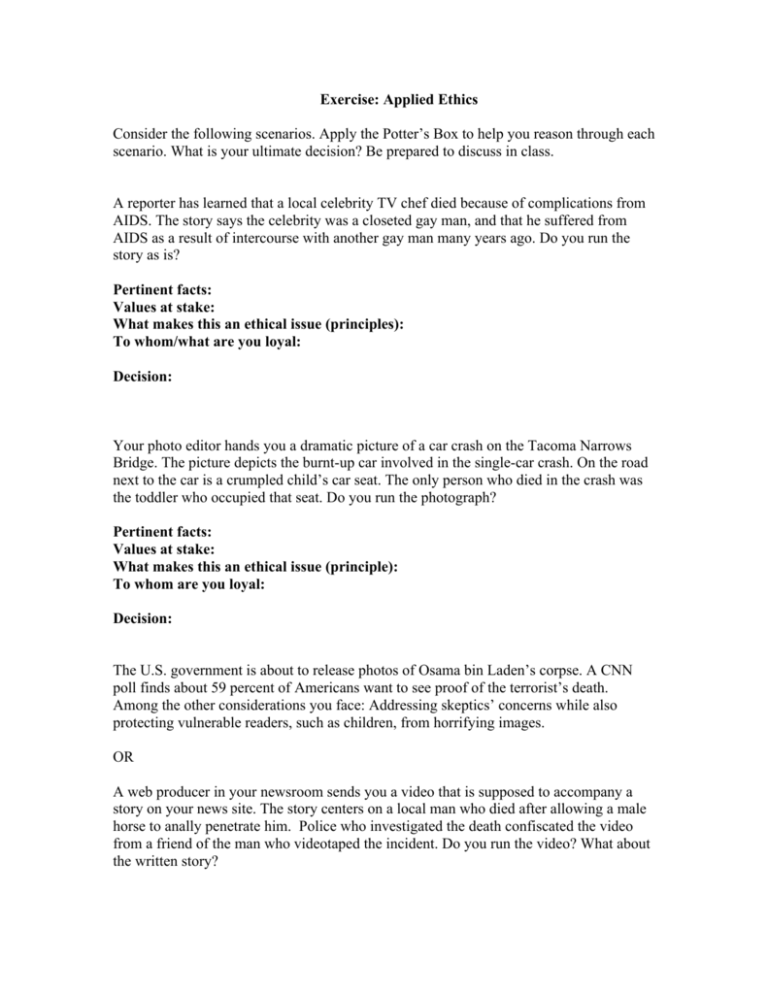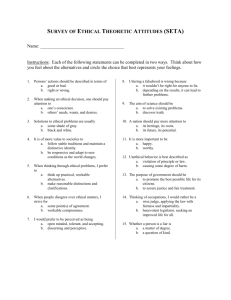Exercise: Applied Ethics
advertisement

Exercise: Applied Ethics Consider the following scenarios. Apply the Potter’s Box to help you reason through each scenario. What is your ultimate decision? Be prepared to discuss in class. A reporter has learned that a local celebrity TV chef died because of complications from AIDS. The story says the celebrity was a closeted gay man, and that he suffered from AIDS as a result of intercourse with another gay man many years ago. Do you run the story as is? Pertinent facts: Values at stake: What makes this an ethical issue (principles): To whom/what are you loyal: Decision: Your photo editor hands you a dramatic picture of a car crash on the Tacoma Narrows Bridge. The picture depicts the burnt-up car involved in the single-car crash. On the road next to the car is a crumpled child’s car seat. The only person who died in the crash was the toddler who occupied that seat. Do you run the photograph? Pertinent facts: Values at stake: What makes this an ethical issue (principle): To whom are you loyal: Decision: The U.S. government is about to release photos of Osama bin Laden’s corpse. A CNN poll finds about 59 percent of Americans want to see proof of the terrorist’s death. Among the other considerations you face: Addressing skeptics’ concerns while also protecting vulnerable readers, such as children, from horrifying images. OR A web producer in your newsroom sends you a video that is supposed to accompany a story on your news site. The story centers on a local man who died after allowing a male horse to anally penetrate him. Police who investigated the death confiscated the video from a friend of the man who videotaped the incident. Do you run the video? What about the written story? Pertinent facts: Values at stake: What makes this an ethical issue (principle): To whom are you loyal: Decision: ********** Cribsheet: Four Steps in Making Ethical Decisions Dr. Ralph Potter of the Harvard Divinity School developed the following model to make ethical decisions. The model has become popular with media workers who have to make on-the-spot ethical decisions virtually throughout the workday: 1. Appraise the facts of the situation. Making a good ethical decision begins with good reporting/fact-gathering. You need all the facts from a variety of sources. Reaching a decision without trying to know all the facts makes an ethical decision impossible. 2. Identifying values. What are your personal values, your organization’s values, your community’s values, the nation’s values? You may place high value on your personal credibility and that of your organization. Certainly, freedom of the press is a value prized by this nation. You value your audience’s right to know, but you may value a specific person’s right to privacy more, for instance. You also value your independence and not being used by special interests or powerful officials to get what they want. 3. Appealing to ethical principles. What are the pertinent principles involved? Why is this issue an ethical conundrum? The principles are not meant to be a shopping list from which you pick and choose items that serve your personal interest. To be ethical, you may have to choose a principle or principles that are far from expedient. 4. Choose loyalties. You owe a certain loyalty to your organization, yes, but you must also be loyal to your customers and to the public at large in a democracy. And what about loyalty to the individuals most affected by the decision (sources in a news story, for instance, who may lose their jobs as a result of talking to you.)




